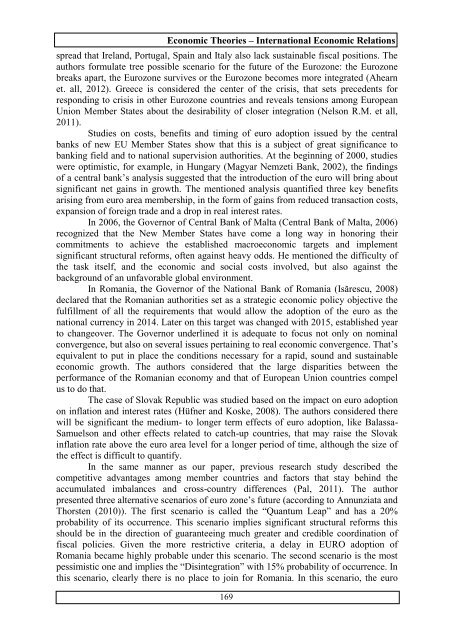View - Centru E-learning de Instruire al Resurselor Umane din ...
View - Centru E-learning de Instruire al Resurselor Umane din ...
View - Centru E-learning de Instruire al Resurselor Umane din ...
You also want an ePaper? Increase the reach of your titles
YUMPU automatically turns print PDFs into web optimized ePapers that Google loves.
Economic Theories – Internation<strong>al</strong> Economic Relationsspread that Ireland, Portug<strong>al</strong>, Spain and It<strong>al</strong>y <strong>al</strong>so lack sustainable fisc<strong>al</strong> positions. Theauthors formulate tree possible scenario for the future of the Eurozone: the Eurozonebreaks apart, the Eurozone survives or the Eurozone becomes more integrated (Ahearnet. <strong>al</strong>l, 2012). Greece is consi<strong>de</strong>red the center of the crisis, that sets prece<strong>de</strong>nts forrespon<strong>din</strong>g to crisis in other Eurozone countries and reve<strong>al</strong>s tensions among EuropeanUnion Member States about the <strong>de</strong>sirability of closer integration (Nelson R.M. et <strong>al</strong>l,2011).Studies on costs, benefits and timing of euro adoption issued by the centr<strong>al</strong>banks of new EU Member States show that this is a subject of great significance tobanking field and to nation<strong>al</strong> supervision authorities. At the beginning of 2000, studieswere optimistic, for example, in Hungary (Magyar Nemzeti Bank, 2002), the fin<strong>din</strong>gsof a centr<strong>al</strong> bank’s an<strong>al</strong>ysis suggested that the introduction of the euro will bring aboutsignificant net gains in growth. The mentioned an<strong>al</strong>ysis quantified three key benefitsarising from euro area membership, in the form of gains from reduced transaction costs,expansion of foreign tra<strong>de</strong> and a drop in re<strong>al</strong> interest rates.In 2006, the Governor of Centr<strong>al</strong> Bank of M<strong>al</strong>ta (Centr<strong>al</strong> Bank of M<strong>al</strong>ta, 2006)recognized that the New Member States have come a long way in honoring theircommitments to achieve the established macroeconomic targets and implementsignificant structur<strong>al</strong> reforms, often against heavy odds. He mentioned the difficulty ofthe task itself, and the economic and soci<strong>al</strong> costs involved, but <strong>al</strong>so against thebackground of an unfavorable glob<strong>al</strong> environment.In Romania, the Governor of the Nation<strong>al</strong> Bank of Romania (Isărescu, 2008)<strong>de</strong>clared that the Romanian authorities set as a strategic economic policy objective thefulfillment of <strong>al</strong>l the requirements that would <strong>al</strong>low the adoption of the euro as thenation<strong>al</strong> currency in 2014. Later on this target was changed with 2015, established yearto changeover. The Governor un<strong>de</strong>rlined it is a<strong>de</strong>quate to focus not only on nomin<strong>al</strong>convergence, but <strong>al</strong>so on sever<strong>al</strong> issues pertaining to re<strong>al</strong> economic convergence. That’sequiv<strong>al</strong>ent to put in place the conditions necessary for a rapid, sound and sustainableeconomic growth. The authors consi<strong>de</strong>red that the large disparities between theperformance of the Romanian economy and that of European Union countries compelus to do that.The case of Slovak Republic was studied based on the impact on euro adoptionon inflation and interest rates (Hüfner and Koske, 2008). The authors consi<strong>de</strong>red therewill be significant the medium- to longer term effects of euro adoption, like B<strong>al</strong>assa-Samuelson and other effects related to catch-up countries, that may raise the Slovakinflation rate above the euro area level for a longer period of time, <strong>al</strong>though the size ofthe effect is difficult to quantify.In the same manner as our paper, previous research study <strong>de</strong>scribed thecompetitive advantages among member countries and factors that stay behind theaccumulated imb<strong>al</strong>ances and cross-country differences (P<strong>al</strong>, 2011). The authorpresented three <strong>al</strong>ternative scenarios of euro zone’s future (accor<strong>din</strong>g to Annunziata andThorsten (2010)). The first scenario is c<strong>al</strong>led the “Quantum Leap” and has a 20%probability of its occurrence. This scenario implies significant structur<strong>al</strong> reforms thisshould be in the direction of guaranteeing much greater and credible coor<strong>din</strong>ation offisc<strong>al</strong> policies. Given the more restrictive criteria, a <strong>de</strong>lay in EURO adoption ofRomania became highly probable un<strong>de</strong>r this scenario. The second scenario is the mostpessimistic one and implies the “Disintegration” with 15% probability of occurrence. Inthis scenario, clearly there is no place to join for Romania. In this scenario, the euro169















